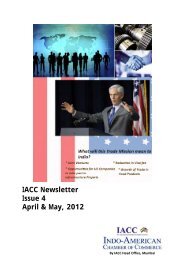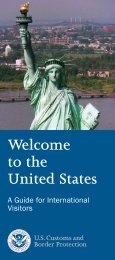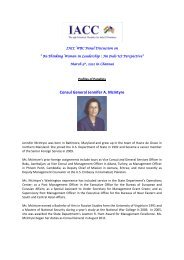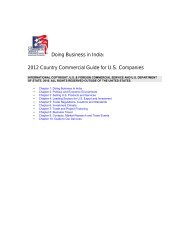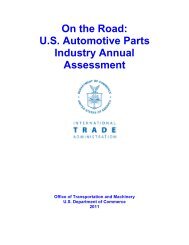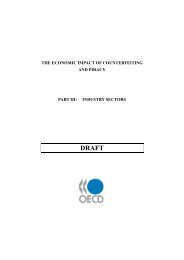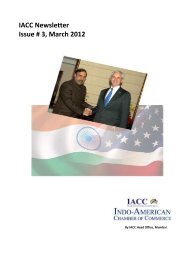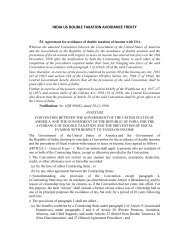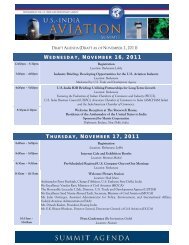Importing into the United States - Indo-American Chamber Of ...
Importing into the United States - Indo-American Chamber Of ...
Importing into the United States - Indo-American Chamber Of ...
Create successful ePaper yourself
Turn your PDF publications into a flip-book with our unique Google optimized e-Paper software.
unless marked in exact conformity with <strong>the</strong>se<br />
requirements.<br />
Movements with opto-electronic display<br />
only and cases designed for use <strong>the</strong>rewith,<br />
whe<strong>the</strong>r entered as separate articles or as components<br />
of assembled watches or clocks, are<br />
not subject to <strong>the</strong> special marking requirements.<br />
These items need only be marked with<br />
<strong>the</strong> marking requirements of 19 U.S.C. 1304.<br />
Parts of any of <strong>the</strong> foregoing not including<br />
those above mentioned.<br />
In addition to <strong>the</strong> special marking requirements<br />
set forth above, all watches of foreign<br />
origin must comply with <strong>the</strong> usual country of<br />
origin marking requirements. Customs considers<br />
<strong>the</strong> country of origin of watches to be <strong>the</strong><br />
country of manufacture of <strong>the</strong> watch movement.<br />
The name of this country should appear<br />
ei<strong>the</strong>r on <strong>the</strong> outside back cover or on <strong>the</strong> face<br />
of <strong>the</strong> dial.<br />
Title IV of <strong>the</strong> Tariff Suspension and Trade<br />
Act of 2000 (P.L. 106-476), also known as <strong>the</strong><br />
Imported Cigarette Compliance Act of 2000,<br />
imposes special requirements on <strong>the</strong> importation<br />
of cigarettes and o<strong>the</strong>r tobacco products.<br />
Importers of cigarettes or o<strong>the</strong>r tobacco products<br />
are urged to contact <strong>the</strong> <strong>United</strong> <strong>States</strong> port<br />
of entry at which <strong>the</strong>ir merchandise will arrive<br />
for information about <strong>the</strong> new requirements.<br />
35. MARKING—FALSE IMPRESSION<br />
Section 42 of <strong>the</strong> Trademark Act of 1946<br />
(15 U.S.C. 1124) provides, among o<strong>the</strong>r things,<br />
that no imported article of foreign origin which<br />
bears a name or mark calculated to induce <strong>the</strong><br />
public to believe that it was manufactured in<br />
<strong>the</strong> <strong>United</strong> <strong>States</strong>, or in any foreign country or<br />
locality o<strong>the</strong>r than <strong>the</strong> country or locality in<br />
which it was actually manufactured, shall be<br />
admitted to entry at any customhouse in <strong>the</strong><br />
<strong>United</strong> <strong>States</strong>.<br />
In many cases, <strong>the</strong> words “<strong>United</strong> <strong>States</strong>,”<br />
<strong>the</strong> letters “U.S.A.,” or <strong>the</strong> name of any city or<br />
locality in <strong>the</strong> <strong>United</strong> <strong>States</strong> appearing on an<br />
imported article of foreign origin, or on <strong>the</strong><br />
containers <strong>the</strong>reof, are considered to be calculated<br />
to induce <strong>the</strong> public to believe that <strong>the</strong><br />
article was manufactured in <strong>the</strong> <strong>United</strong> <strong>States</strong><br />
unless <strong>the</strong> name of <strong>the</strong> country of origin<br />
appears in close proximity to <strong>the</strong> name which<br />
indicates a domestic origin.<br />
Merchandise discovered after conditional<br />
release to have been missing a required country<br />
of origin marking may be ordered redelivered<br />
to Customs custody. If such delivery is not<br />
promptly made, liquidated damages may be<br />
assessed against <strong>the</strong> Customs bond. (See 19<br />
CFR 141.113[a]; cf., 19 CFR Part 172 and Customs<br />
Form 4647.)<br />
An imported article bearing a name or<br />
mark prohibited by Section 42 of <strong>the</strong> Trademark<br />
Act is subject to seizure and forfeiture.<br />
However, upon <strong>the</strong> filing of a petition by <strong>the</strong><br />
importer prior to final disposition of <strong>the</strong> article,<br />
<strong>the</strong> port director of Customs may release it<br />
upon <strong>the</strong> condition that <strong>the</strong> prohibited marking<br />
be removed or obliterated or that <strong>the</strong> article<br />
and containers be properly marked; or <strong>the</strong> port<br />
director may permit <strong>the</strong> article to be exported<br />
or destroyed under Customs supervision and<br />
without expense to <strong>the</strong> government.<br />
Section 43 of <strong>the</strong> Trademark Act of 1946<br />
(15 U.S.C. 1125) prohibits <strong>the</strong> entry of goods<br />
marked or labeled with a false designation of<br />
origin or with any false description or representation,<br />
including words or o<strong>the</strong>r symbols<br />
tending to falsely describe or represent <strong>the</strong><br />
same. Deliberate removal, obliteration, covering,<br />
or altering of required country-of-origin<br />
markings after release from Customs custody is<br />
also a crime punishable by fines and imprisonment<br />
(19 U.S.C. 1304[l]).<br />
IMPORTING INTO THE UNITED STATES<br />
69



